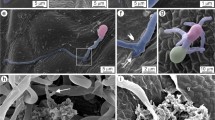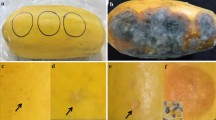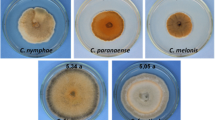Abstract
Elsinoë fawcettii, a fungal pathogen causing scab disease in citrus, is one of the destructive diseases having an adverse role in the fresh fruit market. We observed the infection behaviour of E. fawcettii on young leaves of satsuma mandarin daily and described the time course of symptom development with a focus on morphological changes during disease progress. The E. fawcettii isolate 16–1, belonging to Florida Broad Host Range (FBHR), was infectious and generated typical symptoms on adaxial as well as abaxial surfaces of the leaf. Of the conidia inoculated and adhered, only a few were able to germinate and create typical symptoms. Conidia extended their germ tubes from 1 day post-inoculation where a few possessed globose appressorium-like structures (APL) at their tip. The APL were found on both surfaces while symptoms could be produced without them. Dark regions were induced 1–2 days post-inoculation (dpi) under fluorescent microscopic observation. Cuticle and mesophyll cells including epidermis in the infected dark region were degraded, resulting in cellular necrosis. The adjacent cells of the necrotic region were enlarged and gradually covered leaving a grooved shaped necrotic center and appeared as a first visible symptom 3 dpi. Hyphae were extended through the necrotic epidermis and colonized intra- and inter-cellularly in mesophyll tissue. Also lamellated cell-wall was observed as a boundary between infected and non-infected regions in the lesion after typical symptoms were formed. The lamellation in the cell simultaneously occurred forming a compaction of host cells and a semi-circular arc of lammellated cells was formed on the boundary of the infected and non-infected regions of the lesion.









Similar content being viewed by others
References
Achor, D. S., Albrigo, L. G., & McCoy, C. W. (1991). Developmental anatomy of lesions on ‘Sunburst mandarin leaves initiated by citrus rust mite feeding. Journal of the American Society for Horticultural Science, 116, 663–668.
Agostini, J. P., Bushong, P. M., Bhatia, A., & Timmer, L. W. (2003). Influence of environmental factors on severity of citrus scab and melanose. Plant Disease, 87, 1102–1106.
Apel, K., & Hirt, H. (2004). Reactive oxygen species: metabolism, oxidative stress, and signal transduction. Annual Review of Plant Biology, 55, 373–399.
Barhoom, S., & Sharon, A. (2004). cAMP regulation of "pathogenic" and "saprophytic" fungal spore germination. Fungal Genetics and Biology, 41, 317–326.
Bellincampi, D., Cervone, F., & Lionetti, V. (2014). Plant cell wall dynamics and wall-related susceptibility in plant–pathogen interactions. Frontiers in Plant Science, 5, 1–8.
Cernadas, R. A., & Benedetti, C. E. (2009). Role of auxin and gibberellin in citrus canker development and in the transcriptional control of cell-wall remodeling genes modulated by Xanthomonas axonopodis pv. citri. Plant Science, 177, 190–195.
Chung, K. R. (2011). Elsinoë fawcettii and Elsinoë australis: the fungal pathogen causing citrus scab. Molecular Plant Pathology, 12, 123–135.
Chung, K. R., & Liao, H. L. (2008). Determination of a transcriptional regulator-like gene involved in biosynthesis of elsinochrome phytotoxin by the citrus scab fungus, Elsinoë fawcettii. Microbiology, 154, 3556–3566.
Dangl, J. L., Horvath, D. M., & Staskawicz, B. J. (2013). Pivoting the plant immune system from disease to deployment. Science, 341, 746–751.
Dodds, P. N., & Rathjen, J. P. (2010). Plant immunity: towards an integrated view of plant-pathogen interactions. Nature Reviews Genetics, 11, 529–548.
Gabel, A. W., & Tiffany, L. H. (1987). Host-parasite relations and development of Elsinoë panici. Mycologia, 79, 737–744.
Hématy, K., Cherk, C., & Somerville, S. (2009). Host-pathogen warfare at the plant cell wall. Current Opinion in Plant Biology, 12, 406–413.
Hyun, J. W., Yi, S. H., MacKenzie, S. J., Timmer, L. W., Kim, K. S., Kang, S. K., Kwon, H. M., & Lim, H. C. (2009). Pathotypes and genetic relationship of worldwide collections of Elsinoë spp. causing scab disease of citrus. Phytopathology, 99, 721–728.
Hyun, J. W., Paudyal, D. P., & Hwang, R. Y. (2015). Improved method to increase conidia production from isolates of different pathotypes of citrus scab pathogen Elsinoë spp. Research in Plant Disease, 21, 231–234.
Jones, J. D., & Dangl, J. L. (2006). The plant immune system. Nature, 444, 323–329.
Kay, S., Hahn, S., Marois, E., Hause, C., & Bonas, U. (2007). A bacterial effector acts as a plant transcription factor and induces a cell size regulator. Science, 318, 648–651.
Kay, S., Hahn, S., Marois, E., Wieduwild, R., & Bonas, U. (2009). Detailed analysis of the DNA recognition motifs of the Xanthomonas type III effectors AvrBs3 and AvrBs3Δrep16. The Plant Journal, 59, 859–871.
Kidd, B. N., Kadoo, N. Y., Dombrecht, B., Tekeoglu, M., Gardiner, D. M., Thatcher, L. F., Aitken, E. A. B., Schenk, P. M., Manners, J. M., & Kazan, K. (2011). Auxin signaling and transport promote susceptibility to the root-infecting fungal pathogen Fusarium oxysporum in Arabidopsis. Molecular Plant-Microbe Interactions, 24, 733–748.
Kim, K. W., Hyun, J. W., & Park, E. W. (2004). Cytology of cork layer formation of citrus and limited growth of Elsinoë fawcettii in scab lesions. European Journal of Plant Pathology, 110, 129–138.
Kolattukudy, P. E. (1984). Biochemistry and function of cutin and suberin. Canadian Journal of Botany, 62, 2918–2933.
Kubicek, C. P., Starr, T. L., & Glass, N. L. (2014). Plant cell wall-degrading enzymes and their secretion in plant-pathogenic fungi. Annual Review of Phytopathology, 52, 427–451.
Kunoh, H., Nichoson, R. L., Yosioka, H., Yamaoka, N., & Kobayashi, I. (1990). Preparation of the infection court by Erysiphe graminis: degradation of the host cuticle. Physiological and Molecular Plant Pathology, 36, 397–407.
Lamb, C., & Dixon, R. A. (1997). The oxidative burst in plant disease resistance. Annual Review of Plant Physiology and Plant Molecular Biology, 48, 251–275.
Liao, H. L., & Chung, K. R. (2008a). Cellular toxicity of elsinochrome phytotoxins produced by the pathogenic fungus, Elsinoë fawcettii causing citrus scab. New Phytologist, 177, 239–250.
Liao, H. L., & Chung, K. R. (2008b). Genetic dissection defines the roles of elsinochrome phytotoxin for fungal pathogenesis and conidiation of the citrus pathogen Elsinoë fawcettii. Molecular Plant-Microbe Interactions Journal, 21, 469–479.
Lodha, T. D., Hembram, P., Tep, N., & Basak, J. (2013). Proteomics: a successful approach to understand the molecular mechanism of plant-pathogen interaction. American Journal of Plant Sciences, 4, 1212–1226.
Mendgen, K., Hahn, M., & Deising, H. (1996). Morphogenesis and mechanisms of penetration by plant pathogenic fungi. Annual Review of Phytopathology, 34, 367–386.
Nicholson, R. L., Yoshioka, H., Yamaoka, N., & Kunoh, H. (1988). Preparation of the infection court by Erysiphe graminis. II. Release of esterase enzyme from conidia in response to contact stimulus. Experimental Mycology, 12, 336–349.
Pardo, E. M., Grellet, C. F., Salazar, S. M., Castagnaro, A. P., Ricci, J. C. D., & Arias, M. E. (2012). Histopathology of the resistance to Colletotrichum gloeosporioides of wild strawberries and species related to commercial strawberry. Australian Journal of Crop Science, 6, 1147–1153.
Park, P., & Ikeda, K. -i. (2008). Ultrastructural analysis of responses of host and fungal cells during plant infection. Journal of General Plant Pathology, 74, 2–14.
Pascholati, S. F., Yoshioka, H., Kunoh, H., & Nicholson, R. L. (1992). Preparation of the infection court by Erysiphe graminis f. sp. hordei: cutinase is a component of the conidial exudate. Physiological and Molecular Plant Pathology, 41, 53–59.
Paudyal, D. P., & Hyun, J. W. (2015). Physical changes in satsuma mandarin leaf after infection of Elsinoë fawcettii causing citrus scab disease. The Plant Pathology Journal, 31, 421–427.
Petkovsek, M. M., Stampar, F., & Veberik, R. (2009). Accumulation of phenolic compounds in apples in response to infection by the scab pathogen, Venturia inaequalis. Physiological and Molecular Plant Pathology, 74, 60–67.
Shaw, B. D., Carroll, G. C., & Hoch, H. C. (2006). Generality of the prerequisite of conidium attachment to a hydrophobic substratum as a signal for germination among Phyllosticta species. Mycologia, 98, 186–194.
Simard, M., Rioux, D., & Laflamme, G. (2001). Formation of lingo-suberized tissues in jack pine resistant to the European race of Gremmeniella abietina. Phytopathology, 91, 1128–1140.
Timmer, L. W. 2000. Scab diseases. Editors of the compendium were: L.W. Timmer, S.M. Garnsey and J.H. Graham (Eds.). The American Phytophathological Society, APS Press, pp. 31–32.
Tucker, S. L., & Talbot, N. J. (2001). Surface attachment and pre-penetration stage development by plant pathogenic fungi. Annual Review of Phytopathology, 39, 385–417.
Underwood, W. (2012). The plant Cell Wall: a dynamic barrier against pathogen invasion. Frontiers in Plant Science, 3, 1–6.
Vargas, W. A., Martín, J. M. S., Rech, G. E., Rivera, L. P., Benito, E. P., Díaz-Mínguez, J. M., Thon, M. R., & Sukno, S. A. (2012). Plant defense mechanisms are activated during biotrophic and necrotrophic development of Colletotricum graminicola in maize. Plant Physiology, 158, 1342–1358.
Wang, G. Y., Michailides, T. J., Hammock, B. D., Lee, Y. M., & Bostock, R. M. (2000). Affinity purification and characterization of a cutinase from the fungal plant pathogen Monilinia fructicola (Wint.) honey. Archives of Biochemistry and Biophysics, 382, 31–38.
Whiteside, J. O. (1975). Biological characteristics of Elsinoë fawcettii pertaining to the epidemiology of sour orange scab. Phytopathology, 65, 1170–1177.
Zeigler, R. S., Powell, L. E., & Thurston, H. D. (1980). Gibberellin A4 production by Sphaceloma manihoticola, causal agent of cassava superelongation disease. Phytopathology, 70, 589–593.
Acknowledgements
We kindly acknowledge Dr. Timmer, L. W. for his prompt review and suggestion for improving this manuscript.
Author information
Authors and Affiliations
Corresponding author
Ethics declarations
This study was supported by research program (Project No. PJ012555) for horticultural science & technology development, National Institute of Horticultural and Herbal Science, Rural Development Administration, Republic of Korea. This article does not contain any studies with human participants or animal performed by any of the authors.
Conflict of interest
The authors declare no conflict of interest.
Rights and permissions
About this article
Cite this article
Paudyal, D.P., Hyun, JW. & Hwang, RY. Infection and symptom development by citrus scab pathogen Elsinoë fawcettii on leaves of satsuma mandarin. Eur J Plant Pathol 148, 807–816 (2017). https://doi.org/10.1007/s10658-016-1136-y
Accepted:
Published:
Issue Date:
DOI: https://doi.org/10.1007/s10658-016-1136-y




